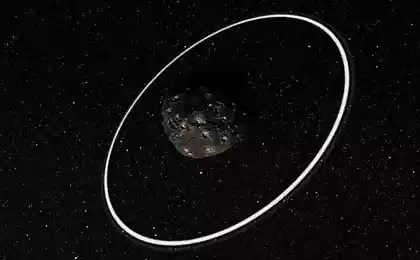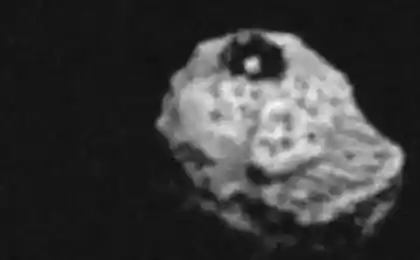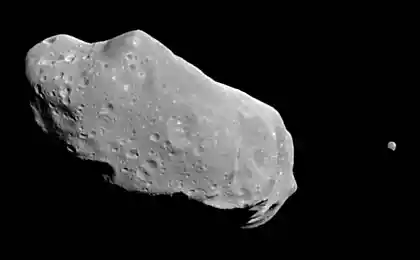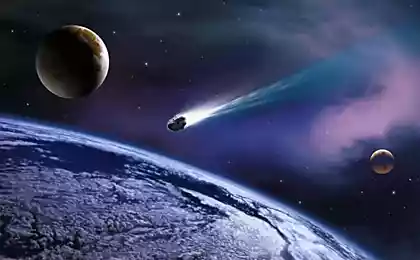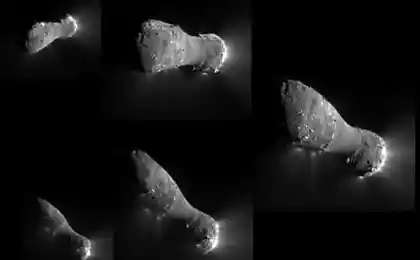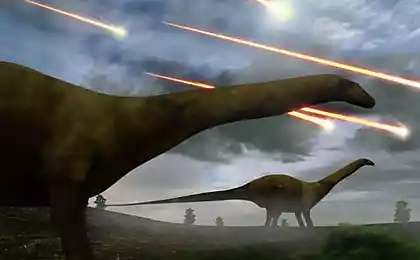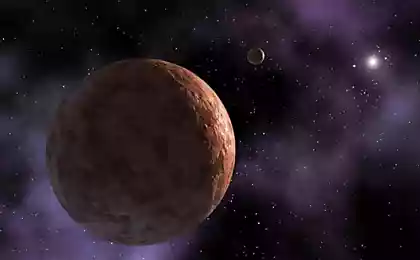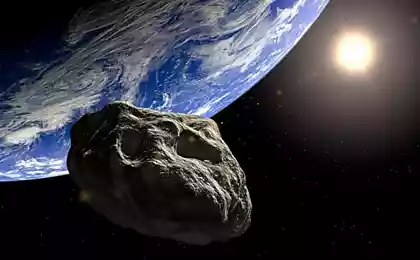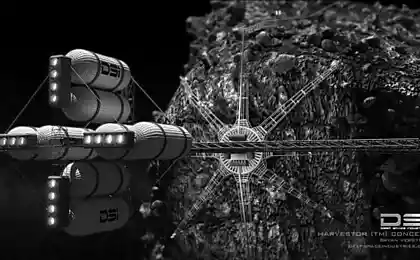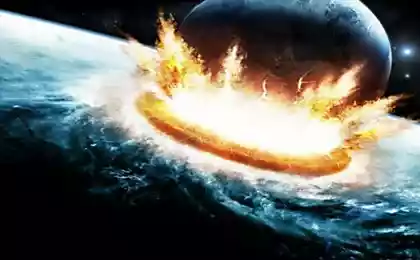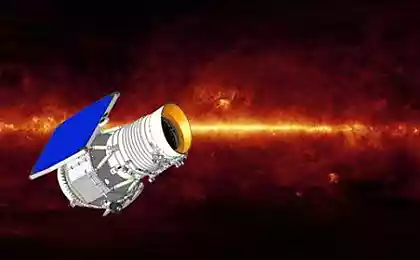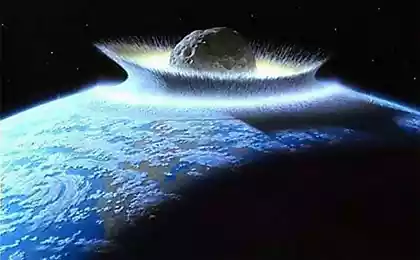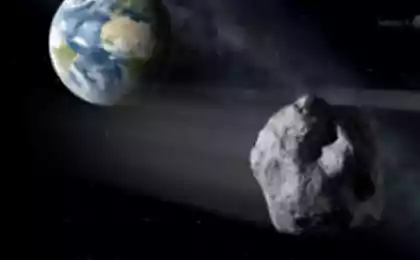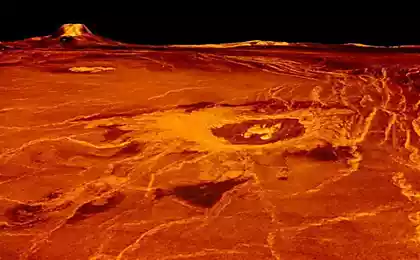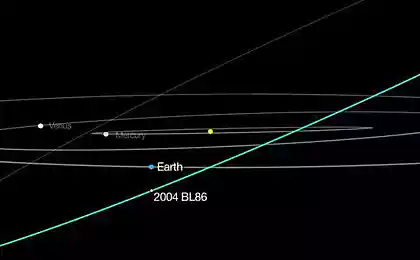927
On Earth flies asteroid
June 21, 2008 the Earth may encounter with the 800-meter asteroid
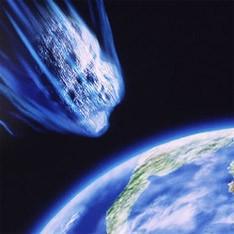
Centenary of the Tunguska meteorite earthlings can meet the most unusual way. As told by astronomers, June 21, 2008, the Earth will crash 800-meter asteroid ...
Centenary of the Tunguska meteorite earthlings can meet the most unusual way. As told by astronomers, June 21, 2008, the Earth will crash 800-meter asteroid. Or, more likely, do not slam - chances are correlated as 6 million to one. Heavenly body called 2006 HZ51 was opened at the end of April this year.
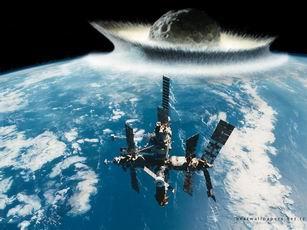
Impressionable bloggers began discussing how to spend the remaining months, that was not excruciatingly painful, and popularizer of science - to explain how hopelessly late to take action. Events, scientists say, will develop as follows: rock from space, at a rate of tens of kilometers per second, enters the atmosphere heats up and, most likely, will fall into the ocean. The giant wave washed away coast, and hot steam will change the composition of the air. The thin oceanic crust will not sustain the impact, and the breach will flow heated substance mantle. The shock wave will pass through the earth, causing the earthquake in another hemisphere. On the continent, in turn, half a kilometer from the body will be ten-crater and dust from the explosion dissipates in the atmosphere and to obscure the sun earthlings. All this, in short, is very unpleasant.
There are, of course, a real danger. For comparison, the chance of crashing into the Earth for the asteroid 99942 Apophis diameter of 400 m, open in 2004, at least a thousand times more than the HZ51. But, as to the expected collision it is still more than 30 years, astronomers say, that affect its trajectory modern methods will not be difficult.
Since 1998, the National Agency of the US National Aeronautics and Space Research is a special register of dangerous bodies. The number of so-called NEO (Near Earth Objects, that is, "NEOs") fall into comets and asteroids that can fly close enough to the Earth. Of the nearly 4 million records only 800 relate to any real danger to the planet. To numerically determine the extent of the danger, it was invented so-called Torino Scale.
Scale were scored - from one to ten - impact probability multiplied by the power. Under this scheme, the asteroid threat is "white" (0 points), the "green" (1 point), "yellow" (2-4), the "orange" (5-7 points), or "red" (8- 10 points).
However, it soon became clear that the scale is relatively uninformative. Events, claiming to be a non-zero score, occurred only rarely. The surprise - pleasant for astronomers and unpleasant for everyone else - was the opening already above named asteroid.
Enthusiasts immediately demanded to equip spaceships to somehow take away from Earth with a diameter of 420 meters of stone, weighing 50 million tons. At NASA, on the other hand, reacted to the news with a suspicious calm, saying that to refine the data do not see the need to disturb a celestial body. The skeptics were right: two months later, the yellow mark in the tables changes to green; 2029 no longer considered suitable for the disaster time. Nevertheless Earth and Apophis will come closer still, and under the influence of Earth's gravity will change the trajectory of the asteroid. How exactly - it is still unknown, but the new calculations show that his return after seven years will be much more alarming.
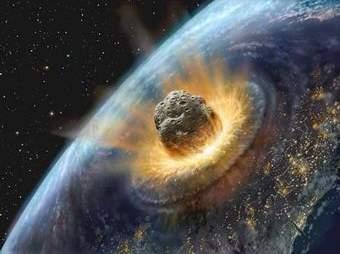
Even today, the Americans offered to send Apophis small device, and at the same time carrying out scientific tasks. On board, he will carry your camera, laser altimeter, a communication system and, perhaps most importantly - the beacon.
Alas, ground-based observations of the asteroid enough to accurately vyschityvaniya its orbit, so the results of this probe must be in the hands of scientists until 2017, when the governments of space-faring nations have to decide - what to do about Apophis.
Perhaps it will need to send a nuclear device to deflect a dangerous flying mount to the side. But curiously, the obvious solution to the layman - a nuclear explosion in orbit - almost immediately declared insolvent. The capacity of a conventional atomic bomb is not enough to break up the body of a kilometer in diameter, and it should be conducted only on thermonuclear weapons. However, and it does not guarantee a perfect effect - flown apart the pieces can by its own gravity to get together, or just an isolated chip will continue to move along the same trajectory.
Ironically, while experts agree the most effective way out is the easiest: directed "shot" The bar for heavy celestial body. It is estimated that this should be enough for cargo weighing about a ton, which have just accelerate to the desired speed.
And last year, the most dangerous body named 2004 VD17 - with a probability of about ten percent of the orbit 580-meter stone and earth intersect in 2102. Add that to better understand the nature of asteroids (which is useful when developing plans to save the planet from threatening objects) need to get as much information about them. How? Probably, a lot of these people slowly bring home a flying Japanese probe Hayabusa, performed the world's first sampling of soil from the asteroid.
But far better if the heavens with your hands to touch the rock geologists. This is not a fantasy, it seems. Once the press has talked about a detailed plan of landing humans on an asteroid.

Centenary of the Tunguska meteorite earthlings can meet the most unusual way. As told by astronomers, June 21, 2008, the Earth will crash 800-meter asteroid ...
Centenary of the Tunguska meteorite earthlings can meet the most unusual way. As told by astronomers, June 21, 2008, the Earth will crash 800-meter asteroid. Or, more likely, do not slam - chances are correlated as 6 million to one. Heavenly body called 2006 HZ51 was opened at the end of April this year.

Impressionable bloggers began discussing how to spend the remaining months, that was not excruciatingly painful, and popularizer of science - to explain how hopelessly late to take action. Events, scientists say, will develop as follows: rock from space, at a rate of tens of kilometers per second, enters the atmosphere heats up and, most likely, will fall into the ocean. The giant wave washed away coast, and hot steam will change the composition of the air. The thin oceanic crust will not sustain the impact, and the breach will flow heated substance mantle. The shock wave will pass through the earth, causing the earthquake in another hemisphere. On the continent, in turn, half a kilometer from the body will be ten-crater and dust from the explosion dissipates in the atmosphere and to obscure the sun earthlings. All this, in short, is very unpleasant.
There are, of course, a real danger. For comparison, the chance of crashing into the Earth for the asteroid 99942 Apophis diameter of 400 m, open in 2004, at least a thousand times more than the HZ51. But, as to the expected collision it is still more than 30 years, astronomers say, that affect its trajectory modern methods will not be difficult.
Since 1998, the National Agency of the US National Aeronautics and Space Research is a special register of dangerous bodies. The number of so-called NEO (Near Earth Objects, that is, "NEOs") fall into comets and asteroids that can fly close enough to the Earth. Of the nearly 4 million records only 800 relate to any real danger to the planet. To numerically determine the extent of the danger, it was invented so-called Torino Scale.
Scale were scored - from one to ten - impact probability multiplied by the power. Under this scheme, the asteroid threat is "white" (0 points), the "green" (1 point), "yellow" (2-4), the "orange" (5-7 points), or "red" (8- 10 points).
However, it soon became clear that the scale is relatively uninformative. Events, claiming to be a non-zero score, occurred only rarely. The surprise - pleasant for astronomers and unpleasant for everyone else - was the opening already above named asteroid.
Enthusiasts immediately demanded to equip spaceships to somehow take away from Earth with a diameter of 420 meters of stone, weighing 50 million tons. At NASA, on the other hand, reacted to the news with a suspicious calm, saying that to refine the data do not see the need to disturb a celestial body. The skeptics were right: two months later, the yellow mark in the tables changes to green; 2029 no longer considered suitable for the disaster time. Nevertheless Earth and Apophis will come closer still, and under the influence of Earth's gravity will change the trajectory of the asteroid. How exactly - it is still unknown, but the new calculations show that his return after seven years will be much more alarming.

Even today, the Americans offered to send Apophis small device, and at the same time carrying out scientific tasks. On board, he will carry your camera, laser altimeter, a communication system and, perhaps most importantly - the beacon.
Alas, ground-based observations of the asteroid enough to accurately vyschityvaniya its orbit, so the results of this probe must be in the hands of scientists until 2017, when the governments of space-faring nations have to decide - what to do about Apophis.
Perhaps it will need to send a nuclear device to deflect a dangerous flying mount to the side. But curiously, the obvious solution to the layman - a nuclear explosion in orbit - almost immediately declared insolvent. The capacity of a conventional atomic bomb is not enough to break up the body of a kilometer in diameter, and it should be conducted only on thermonuclear weapons. However, and it does not guarantee a perfect effect - flown apart the pieces can by its own gravity to get together, or just an isolated chip will continue to move along the same trajectory.
Ironically, while experts agree the most effective way out is the easiest: directed "shot" The bar for heavy celestial body. It is estimated that this should be enough for cargo weighing about a ton, which have just accelerate to the desired speed.
And last year, the most dangerous body named 2004 VD17 - with a probability of about ten percent of the orbit 580-meter stone and earth intersect in 2102. Add that to better understand the nature of asteroids (which is useful when developing plans to save the planet from threatening objects) need to get as much information about them. How? Probably, a lot of these people slowly bring home a flying Japanese probe Hayabusa, performed the world's first sampling of soil from the asteroid.
But far better if the heavens with your hands to touch the rock geologists. This is not a fantasy, it seems. Once the press has talked about a detailed plan of landing humans on an asteroid.

